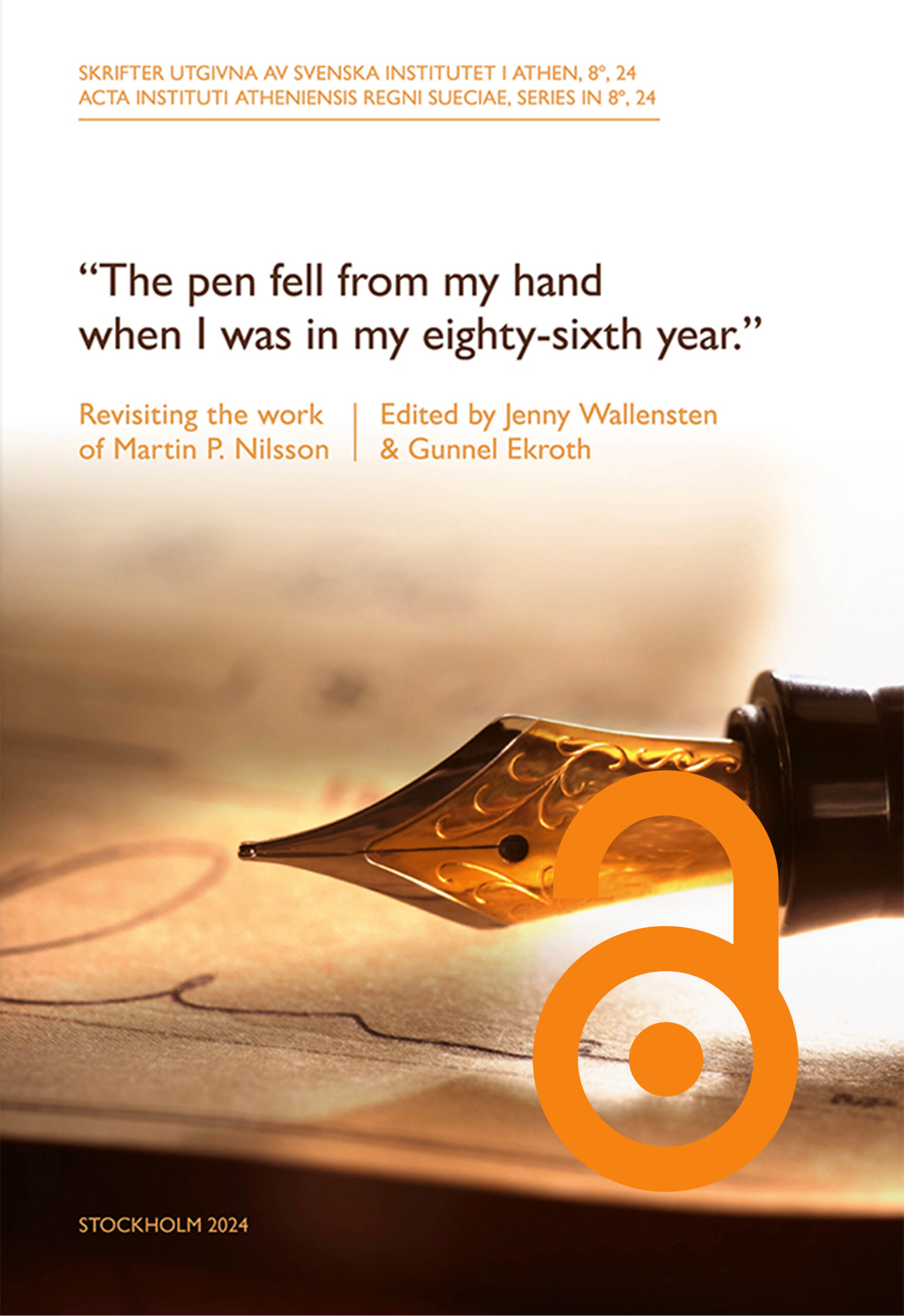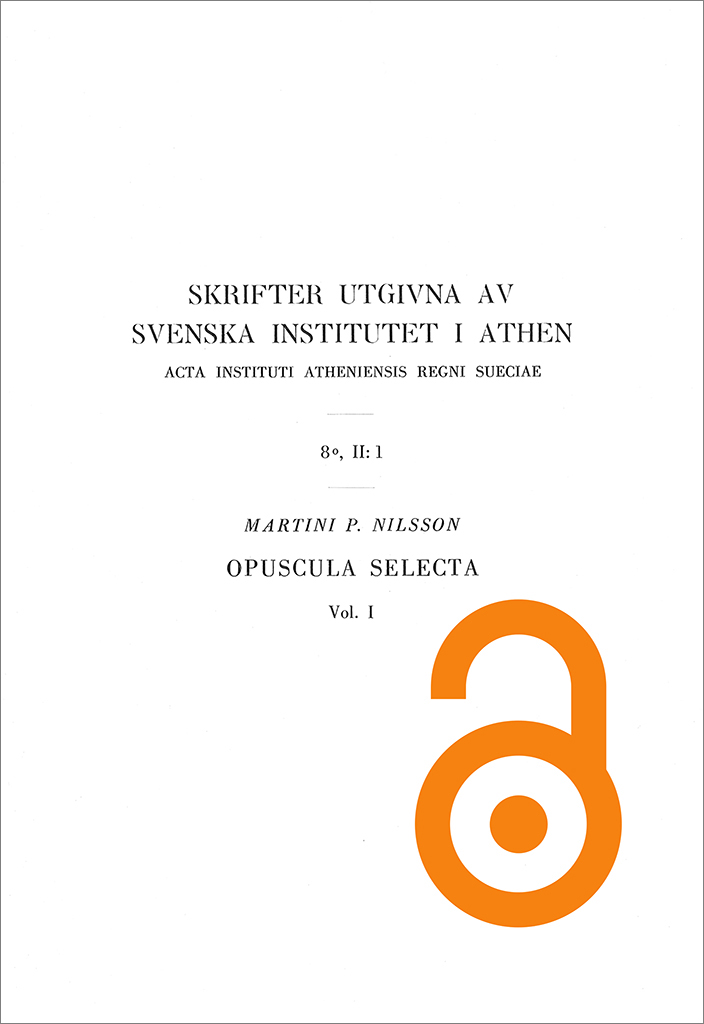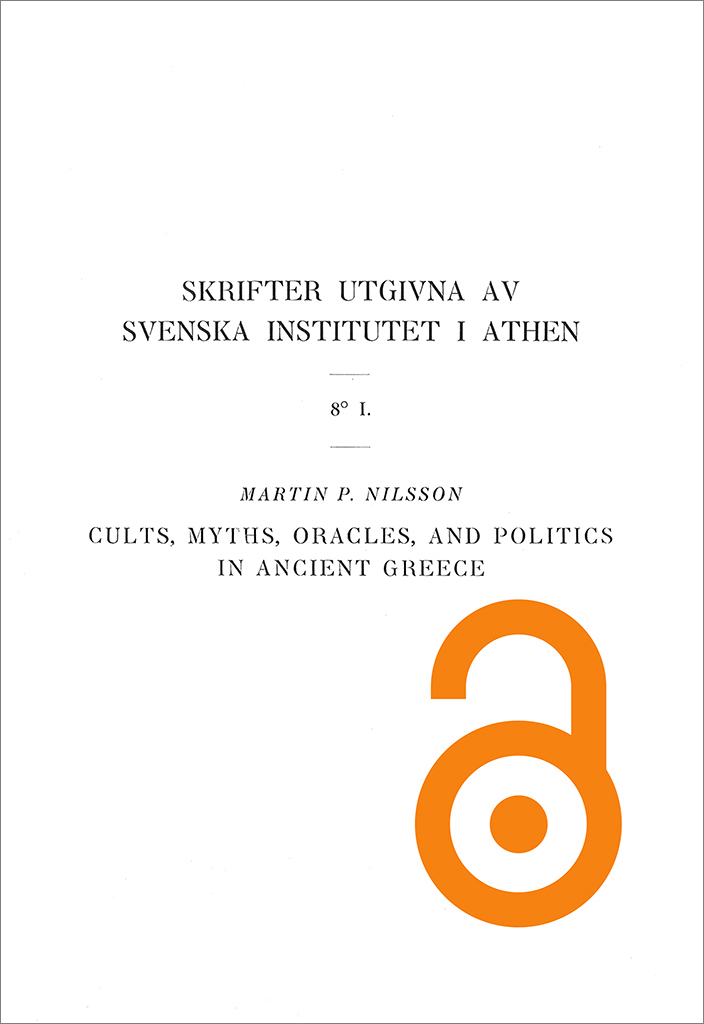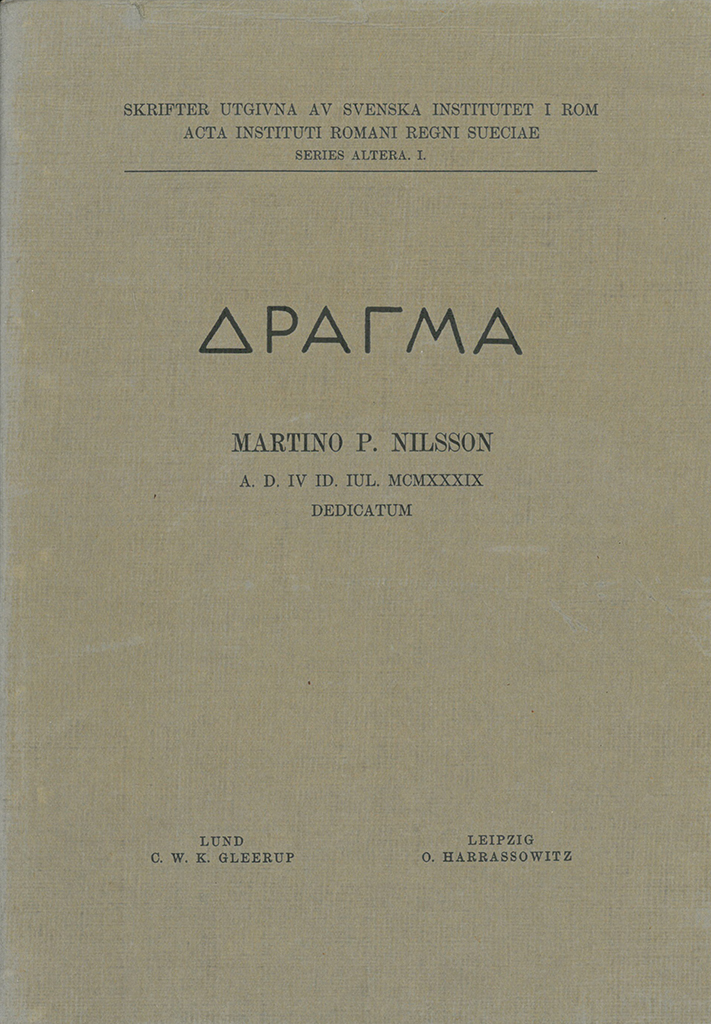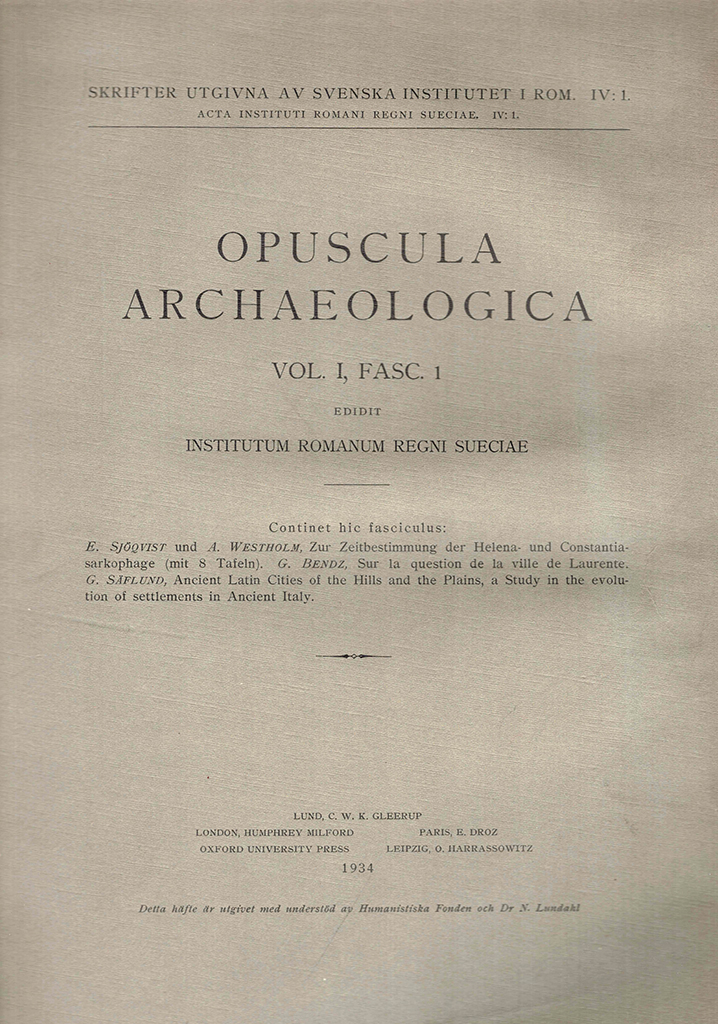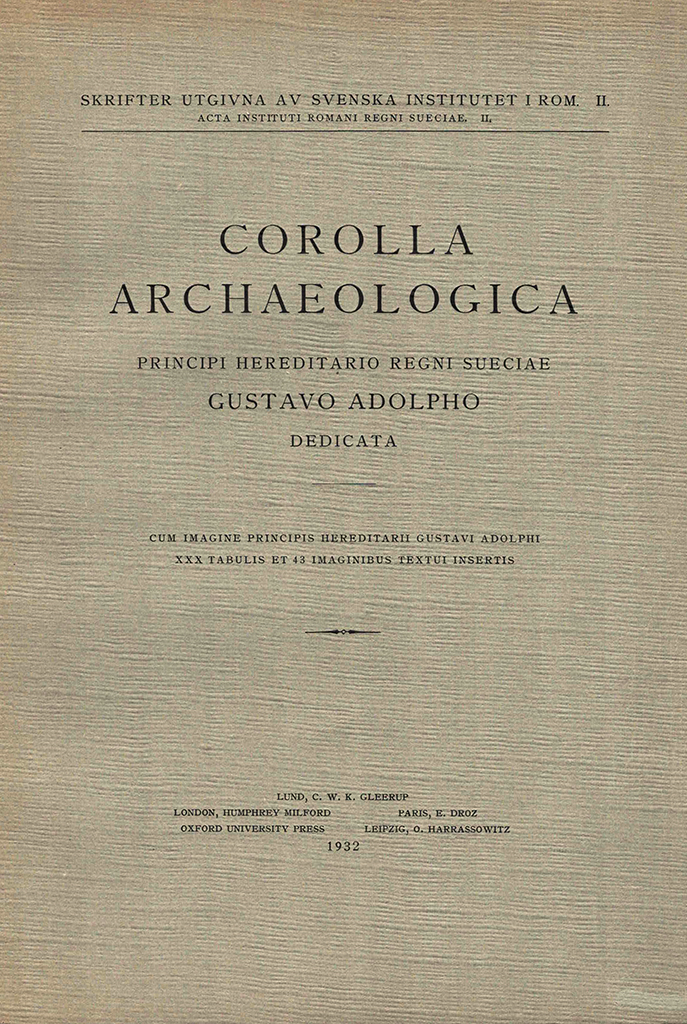Published by the Swedish Institute at Athens. Distributed by Eddy.se AB. All content available with open access, use links below. “The pen fell from my hand when I was in my eighty-sixth year.” Revisiting the work of Martin P. Nilsson Edited by Jenny Wallensten & Gunnel Ekroth https://doi.org/10.30549/actaath-8-24 2017 marked the 50th anniversary of both the death of Martin P. Nilsson, the eminent Swedish scholar of ancient Greek religion, and the publication of the third edition of his monumental Geschichte der griechischen Religion. Nilsson’s scholarly output was huge, with a production of around 20 items annually, and he touched upon most aspects of the study of ancient Greek religion, be it in a book or an article, in a footnote or an in-depth argument. This volume constitutes a re-reading of Nilsson in the light of new ancient evidence, and modern methods and theoretical approaches. Five leading researchers in this field of religion revisit major works of Nilsson’s oeuvre—Geschichte der griechischen Religion, vols 1 and 2 (Jon Mikalson and Eftychia Stavrianopoulou), Greek folk religion (Vinciane Pirenne-Delforge), Minoan-Mycenaean religion (Matthew Haysom) and Greek piety (Michael D. Konaris)—in order to explore whether his works today are mainly touched upon with just the usual…
Published by the Swedish Institute at Athens. Out of print. Open access, use link below. The Dionysiac mysteries of the Hellenistic and Roman age By Martin P. Nilsson https://doi.org/10.30549/actaath-8-05 Conclusions (excerpt) The mysteries of Dionysos appealed to well-to-do people who loved a pleasant and luxurious life. The banquet of the blessed Dead appealed to the taste of a public that was fond of the pleasures of life and did not take religion too seriously. The mysteries of Dionysos appealed to people who from education and conservatism kept to the old culture and religion and yielded less easily to the lure of the more demanding foreign religions, but who still wanted a little thrill of religion as a spice to the daily routine. These characteristics explain the popularity of the Bacchic mysteries of the well-to-do classes, and they explain also why they have left so few traces, except for inscriptions and monuments, in the history of late paganism. These people were not in earnest about religion. The creation of new Dionysiac mysteries in the Hellenistic age and their popularity in Roman times, the attachment of their adherents to the enjoyment of life, their belief in a happy afterlife, their love of…
Published by the Swedish Institute of Classical Studies in Rome. Out of print. Opuscula Romana 1 Arvid Andrén, ‘Scavo sull’Acropoli di Ardea. Rapporto preliminare’, pp. 1–20 Ragnhild Billig, ‘Die Kirchenpläne “al modo antico” von Sebastiano Serlio’, pp. 21–38 Christian Callmer, ‘Flavio Biondo’, pp. 39–49 Einar Gjerstad, ‘The Fortifications of Early Rome’, pp. 50–65 Krister Hanell, ‘Die Form der römischen Eigennamen bei Polybios’, pp. 66–76 Martin P. Nilsson, ‘Roman and Greek domestic cult’, pp. 77–85 Erik Sjöqvist, ‘Kaisareion’, pp. 86–108 J. Svennung, ‘Phaselus ille. Zum 4. Gedicht Catulls’, pp. 109–124 Bengt Erik Thomasson, ‘Iscrizioni del Sepolcreto di Via Ostiense’, pp. 125–152 Hhilding Thylander, ‘La denomination chez Cicéron dans les letteres à Atticus’, pp. 153–159 Olof Vessberg, ‘Roman Portrait Art in Cyprus’, pp. 160–165 Erik Welin, ‘Ara Martis in Campo. Zur Frage der Bedeutung und des Umfanges des Campus Martius’, pp. 166–190 Åke Åkerström, ‘Untersuchungen über die figürlichen Terrakottafriese aus Etrurien und Latium’, pp. 191–231 Bibliographical information Opuscula Romana 1 (Skrifter utgivna av Svenska institutet i Rom, 4°, 18), Lund 1954, pp. 231. ISSN 0081-993X.
Published by the Swedish Institute at Athens. Distributed by Astrom Editions / out of print. Opuscula selecta, linguis Anglica, Francogallica, Germanica conscripta Vol. 1. By Martin P. Nilsson. Out of print. Open access, use link below. https://doi.org/10.30549/actaath-8-02-01 Lectori benevolenti Amicis et collegis, qui Actis Instituti Atheniensis Regni Sueciae praesunt, monentibus ut scripta mea minora collecta publici iuris facerem, tanta aestimatione mei sane valde gravisus sum. Neque tamen fieri non potuit, quin scrupulus quidam iniceretur, reputanti quanto simplicius negotium foret, si post mortem auctoris illa ederentur, quippe cum ad verbum, apertis solum mendis correctis, exprimi par esset. Qui vero sua ipse opera iterum prelo mandare audeat, ab eo tuo iure exspectes, ut illa diligenter, novissima quaeque scripta et inventa respiciens. Quod si ego facere aggressus essem, vereor ne futurum fuerit ut vitae spatium seni non sufficeret. Itaque satis habui paucissima et quae iamdudum adnotassem addere, more solito uncis inclusa. Menda tacitus correxi. Multa sane opuscula per longum aevum conscripsi, neque omnia denuo edere placuit. Exclusi fere: quae in seriem aliquam inserta tamen separatim veneunt; quae lingua suetica composita sunt (cum multa tum de vetustis moribus popularium meorum); quae in encyclopaediis, imprimis ea quam Pauly et Wissowa institerunt, disputavi; quae librorum alienorum existimator scripsi;…
Published by the Swedish Institute at Athens. Out of print. Open access, use link below. Cults, myths, oracles and politics in ancient Greece By Martin P. Nilsson https://doi.org/10.30549/actaath-8-01 Preface This little book is an outcome of some leisure hours, spared from more exacting work. It does not pretend to offer anything new, but as the facts have never been collected and as some unwarranted opinions on the interrelation of Greek mythology and cults and the social and political life of the Greeks have been put forward, a comprehensive survey may be of some use. Oracles were also part of Greek religion and were extensively used for influencing public opinion. They are treated in a separate chapter. I append a discussion of the Ionian phylae and another of the phratries. They are highly technical and the result is meagre, but they have some importance as throwing light upon the interplay of religion and social life. I am deeply indebted to Professors A. Wifstrand and Hj. Frisk for valuable and clarifying help in certain difficult problems. My warmest thanks are due to Professor H.J. Rose who, with self-sacrificing kindness, has gone through my manuscript, correcting my English style, and read the first…
Published by the Swedish Institute of Classical Studies in Rome. Out of print. ΔΡΑΓΜΑ. Martino P. Nilsson A. D. IV. Iul. anno MCMXXXIX dedicatum Edited by Krister Hanell, Erik J. Knudtzon & Natan Valmin Contents Arvid Andrén, ‘Una testa fittile etrusca del V secolo a. C.’ Ernst Arbman, ‘Mythic and religious thought’ Bertil Axelson, ‘A problem of genuinness in Juvenal’ Gerhard Bendz, ‘Eine lateinische Exemplabiographie’ Franz Blatt, ‘Un nouveau texte d’une apologie anonyme chrétienne’ Christian Blinkenberg, ‘Règlements de sacrifices rhodiens’ Axel Boëthius, ‘Vitruvius and the Roman architecture of his age’ Sture Bolin, ‘Der Solidus’ Efraim Briem, ‘Totemism and animal worship’ Samson Eitrem, ‘Daulis in Delphoi und Apollons Strafe’ Knud Friis Johansen, ‘Achill bei Chiron’ Einar Gjerstad, ‘Über die Baugeschichte des republikanischen Comitium’ Harald Hagendahl, ‘La « comédie » latine au XIIe siècle et ses modèles antiques’ Krister Hanell, ‘Das traditionelle Anfangsjahr der römischen Republik’ Carsten Höeg, ‘The second pleading of the Verres trial’ Johannes Lindblom, ‘Job and Prometheus’ Hans Peter L’orange, ‘Ein unbekanntes Augustusbildniss’ Einar Löfstedt, ‘Zum Stil des Tacitus’ Ernst Nachmanson, ‘Remarques syntaxiques sur les écrits Hippocratiques’ Wilhelm Norlind, ‘Astronomische Streifzüge in Joen Petri Klints „Om meteorer“’ Henrik Samuel Nyberg, ‘Bemerkungen zum „Buch der Götzenbilder“ von Ibn al-Kalbī’ Anders…
Published by the Swedish Institute of Classical Studies in Rome. Out of print. Opuscula Archaeologica 1 Contents Fasc. 1 Erik Sjöqvist & Alfred Westholm, ‘Zur Zeitbestimmung der Helena- und Constantiasarkophage’, pp. 1–46 Gerhard Bendz, ‘Sur la question de la ville de la Laurente’, pp. 47–63 Gösta Säflund, ‘Ancient Latin cities of the hills and the plains, a study in the evolution of settlements in ancient Italy’, pp. 64–85 Fasc. 2 Gösta Säflund, ‘The dating of ancient fortifications in Southern Italy and Greece, with special reference to Hipponium’, pp. 87–119 Martin P. Nilsson, ‘The triumphal arch and town planning’, pp. 120–128 Axel W. Persson, ‘Die hellenistische Schiffbaukunst und die Nemischiffe’, pp. 129–163 Axel Boethius, ‘Das Stadtbild im spätrepublikanischen Rom’, pp. 164–195 Karl Lehmann-Hartleben & John Lindros, ‘Il palazzo degli orti Sallustiani’, pp. 196–227 Bibliographical information Opuscula Archaeologica 1 (Skrifter utgivna av Svenska institutet i Rom 4°, 4:1 & 2), Lund 1934 & 1935. ISSN 0081-993X. Softcover: 227 pages + plates Reviews American Journal of Archaeology 39:1, 1935, 164 (Tenney Frank) https://doi.org/10.2307/498788 The Classical Review 49:6, 1935, 237-238 (R. Gardner) https://doi.org/10.1017/S0009840X00069432 The Journal of Roman Studies, 25:1, 1935, 114-115 (C.G. Hardie) https://doi.org/10.2307/296572
Published by the Swedish Institute of Classical Studies in Rome. Out of print. Corolla Archaeologica Principi Hereditario Regni Sueciae Gustavo Adolpho dedicata Contents O.A. Danielsson, ‘Annius von Viterbo über die Gründungsgeschichte Roms’, pp. 1–16 B. Wijkström, ‘Welche sind die Tempel auf der Piazza Argentina?’, pp. 17–30 Bengt Wall, ‘Porticus Minucia’, pp. 31–54 Erik Wistrand, ‘Ante atria’, pp. 55–63 Gösta Säflund, ‘Porta Mugonia und Sacra Via’, pp. 64–71 Åke Åkerström, ‘Lacus Curtius und seine Sagen’, pp. 72–83 Axel Boethius, ‘The neronian “Nova Urbs”. Notes on Tacitus’ Annales, XV, 38 et. Seq., and Suetonius’ Biography of Nero, chapters 16 and 38’, pp. 84–97 Arvid Andrén, ‘Terracotte di Ardea’, pp. 98–117 Lars Fagerlind, ‘The transformations of the Corinthian capital in Rome and Pompeii during the later Republican period. Together with a criticism of Tenney Frank’s History of the building of the Temple of Magna Mater’, pp. 118–131 Martin P. Nilsson, ‘The origins of the triumphal arch’, pp. 132–139 Tönnes Kleberg, ‘Deux noms de consuls romains’, pp. 140–144 Einar Gjerstad, ‘The palace at Vouni. A study in architectural history’, pp. 145–171 Alfred Westholm, ‘Sculptures from the temple-site at Soli-Holades’, pp. 172–188 Erik Sjöqvist, ‘Some Cypriot Iron Age tombs’, pp. 189–207 Axel W. Persson, ‘Die…

